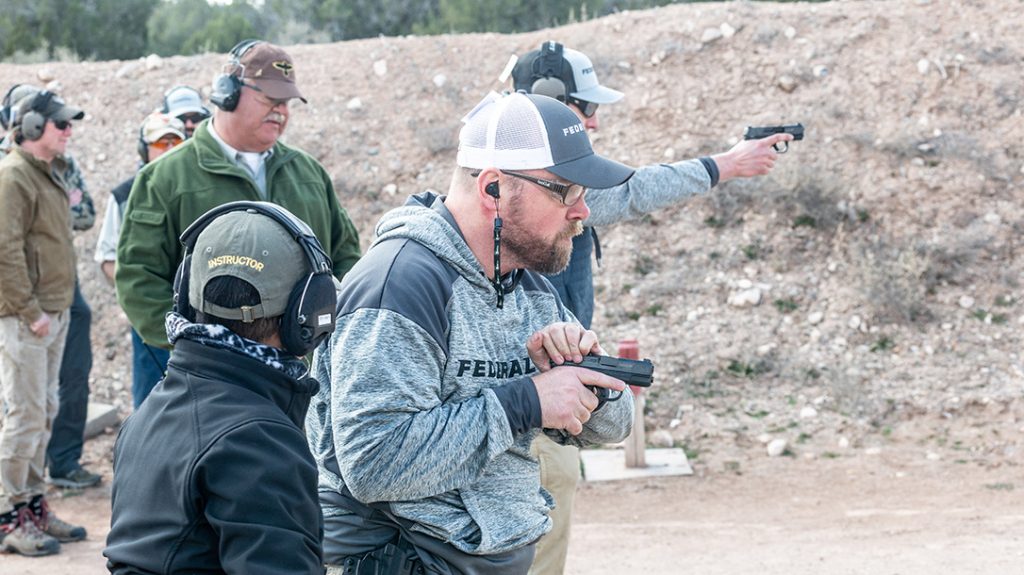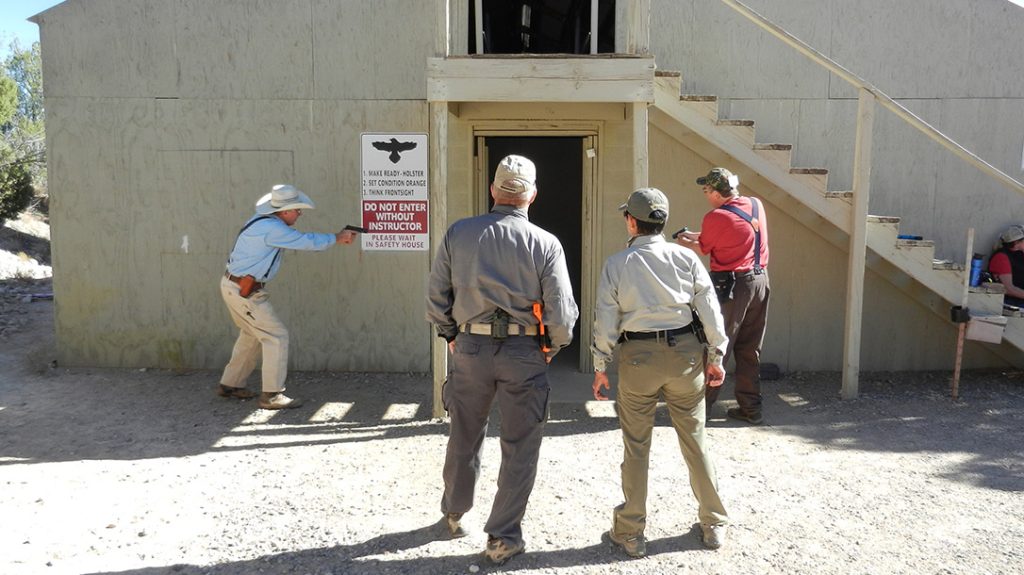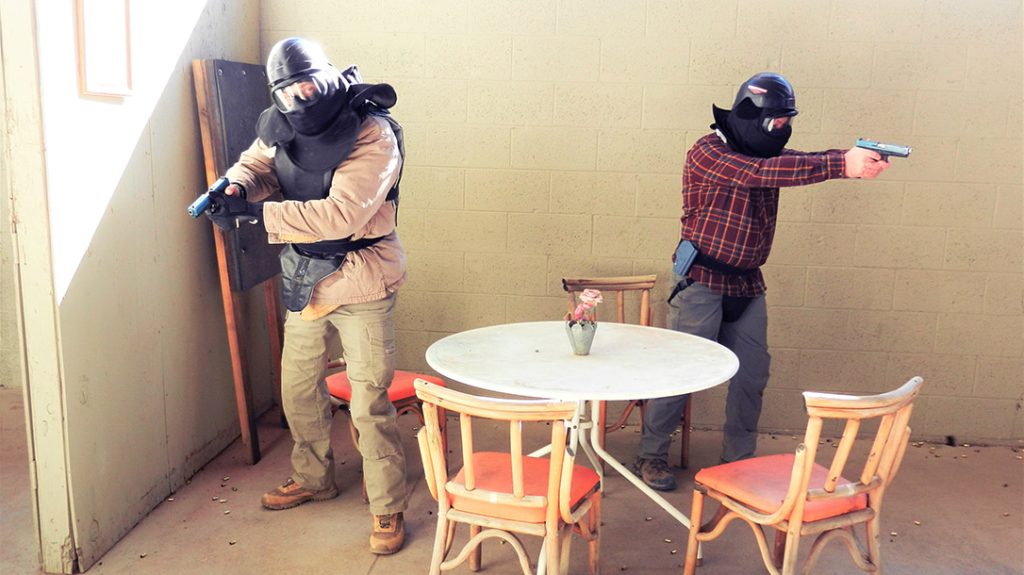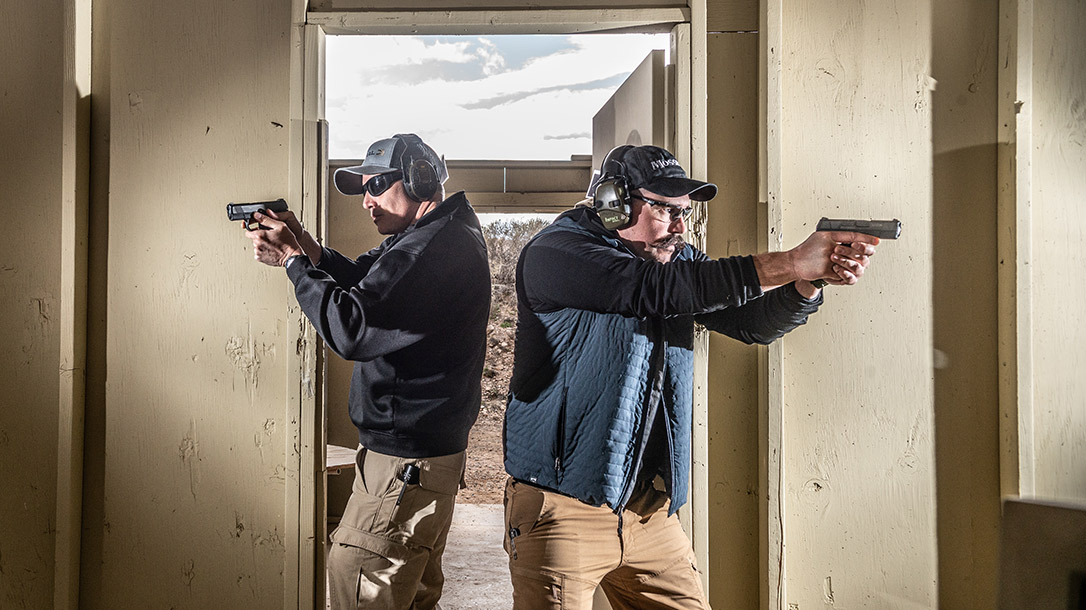You’re facing a deadly threat. But, you’re not a member of a SWAT team or a military special ops unit that trains several days a week and has a full array of armament and protective gear. And there are just the two of you. When it comes to a scenario like this, training like Gunsite’s Team Tactics course will ensure you’re ready.
Gunsite’s Team Tactics Course
Maybe you’ve come home from an evening out and find the front door kicked in and your teenager is screaming somewhere in the house. It could also be you’re in a restaurant, shopping mall or office building when active shooters burst in. Maybe you’re left in the wake of a disaster or there are rioters and looters everywhere.
The truth is, ordinary citizens can find themselves suddenly thrust into deadly situations where they might need to navigate a dangerous labyrinth, maybe in the dark, maybe in smoke-filled corridors, with possible threats behind any door or around any corner.
Advertisement — Continue Reading Below
If you ever find yourself in a position of trying to escape with your life, you might not have to go it alone. Perhaps you’re with your spouse or a hiking companion or a co-worker. The two of you might be able to work together as a team to find a solution. That solution doesn’t have to be perfect and there are no absolute correct answers. A successful conclusion is one in which you survive.
Those were just some of the considerations of our little group while attending Team Tactics for Two course at Gunsite Academy. Mossberg & Sons sponsored the course, along with DeSantis Gunhide and Federal Premium.
At Home On The Range
Obviously, there are some benefits to having a partner in a critical situation. When there are two of you, you have twice the eyes to watch for signs of danger as you make your way cautiously and carefully to safety. And if you’re both trained and armed, you have twice the firepower. Working together, you’re responsible for just half of each room or area you pass through. You trust that your partner has your back.
Advertisement — Continue Reading Below
This Gunsite course includes classroom instruction, live-fire training on an outdoor range, exercises in navigating safely through buildings with a partner using the inert “blue” guns, and finally, force-on-force scenarios using Simunition’s non-lethal marking rounds and role players, both indoors and out. Each segment complements the others for a well-rounded, beneficial curriculum.

Classroom instruction and discussions helped familiarize the concepts taught and provided feedback on the training exercises. There was a substantial live-fire range portion of the course. Gunsite emphasized gun handling and marksmanship skills, as those skills are important under the stress of a critical situation. Additionally, our group had the advantage of being able to evaluate the Mossberg MC2c compact pistols we used throughout.
Advertisement — Continue Reading Below
Keys To Consider
Paired and moving through the Gunsite shoot houses, initially with the solid-plastic “blue” guns, impressed upon us how many things we had to consider. We had to continually scan for threats and clear possible hiding places, make decisions on how to move safely through doorways into adjoining rooms taking angles to expose as little of ourselves as possible. We found we might have to discern friend from foe in a split second when encountering others. Naturally, we were mindful to point our muzzles safely away from our partners while staying ready to engage a threat.

1. Safety first
Because we were tackling these scenarios as civilians, we were more interested in finding a safe exit or getting to an endangered loved one than we were in clearing every room or looking for contraband. And because civilians don’t make arrests, often the best solution might be to retreat rather than to engage a threat.
Advertisement — Continue Reading Below
2. Preparation
Another important consideration is the level of training and preparedness of the team members. Maybe your spouse has limited training. Maybe your co-worker only has a five-shot snub-nose revolver, while you have a 15-round semi-auto with spare magazines. Even so, each member of a two-person team plays an important role. Even if they just provide an extra set of eyes and ears.
3. Communicate

As the course proceeded, it was evident that communication between partners was most important. You had to let your partner know what you were seeing, especially concerning any potential trouble spots. And communication was important in being able to keep moving and continually assess as a team. Not all communications need to be verbal. Sometimes a hand motion or a nod is all that is necessary.
Advertisement — Continue Reading Below
4. No Advance Notice
The force-on-force portion of the course gives participants a chance to put everything learned to the test in an induced-stress atmosphere, which feels closer to being real. We had three scenarios during this particular course, including a robbery at a restaurant, a hostage situation in a house, and an outdoor outing where the threat wasn’t obvious initially. We were suitably outfitted with protective equipment during these exercises, yet we were just as likely in the heat of “battle” to feel the sting of a tactical miscue as we were from a Simunition hit.

These scenarios provided valuable lessons. Although we were unaware of the specifics going in, we did know we were walking into trouble. In the real world, we will have no advance notice. And a real-world scenario will likely present unique challenges that can’t all be covered in a two-day course.
Advertisement — Continue Reading Below
Keep On Training
Working on your team tactics should be a continual process and the communication needs to begin before things get critical. Gunsite encouraged us to take the ideas home and discuss them with family members. Heightened awareness of possible signs of trouble, agreement on the use of code words between team members and spotting potential safe exit locations are all things that can be done in advance.
Gunsite is known for its excellent firearm training courses and I found this one to be especially relevant in today’s world. The instructors of this particular course session—Mario Marchman, Paul Kultala and Il Ling New—were highly capable, encouraging and knowledgeable. We also had the benefit this session of the expertise and experience of Sheriff Jim Wilson and Gunsite CEO Ken Campbell, himself a former sheriff.
While training from professionals of this caliber is highly recommended, I understand that not everyone will be able to take advantage of it. Still, if you can’t take Gunsite’s Team Tactics course, it would be a wise move to sit down with friends and family to discuss how you might handle working together to survive some of these dangerous encounters before you’re thrust into such a situation.
Advertisement — Continue Reading Below
This article was originally published in the Combat Handguns March/April 2022 issue. Subscription is available in print and digital editions at OutdoorGroupStore.com. Or call 1-800-284-5668, or email subscriptions@athlonmediagroup.com.
























